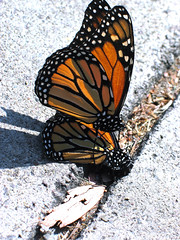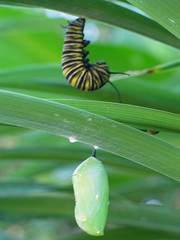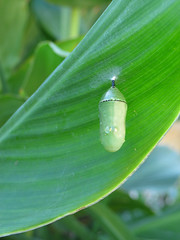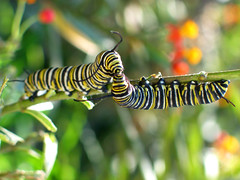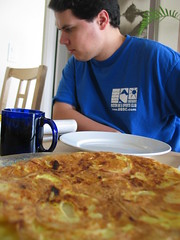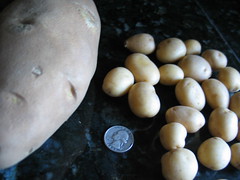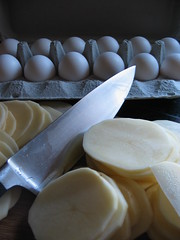mardi, octobre 31, 2006
good ol' boy advertising
In case you missed it, the RNC is running this ad in Tennessee.
It made the national news cycle for its borderline-racist undertones (Democratic TN-Senate candidate Harold Ford is black, and the ad has received criticism even from Ford’s Republican opponent for race-baiting – the argument being that the ditzy blonde girl with no visible clothing is a reference to Ford’s well-publicized tendency to date white women).
Congressman, call me is the parody response to the ad above.
My fave quote from this spoof: "If the constitution can't protect us from terrorists, why protect it?"
Via Slater
remember to vote, hope it counts
But some of these obstacles are making it nearly impossible to vote (even for those who are legally eligible). The most despicable part? It's engineered by partisans who are looking to win elections that hang on razor-thin margins.
Take a look at some of the more insidious obstacles in various states.
Remember to Vote, Hope It Counts
On Nov. 7, many voters will encounter new voting machines, new computerized voter lists and new rules regarding registration and ID requirements. As primaries earlier this year demonstrated, local officials and poll workers are overwhelmed by all the changes — some of them engineered by mischievous partisans who have passed laws and rules that would block many eligible citizens from voting.
There is a silent disenfranchisement afoot — one that could affect hundreds of thousands of voters. That’s bad for democracy. In the 2004 presidential election, some states were decided by less than 1 percent of the vote. This year, dozens of Congressional races could be close enough that vote suppression would affect them.
What follow are examples of ways the vote could be suppressed next week around the country. Problems listed in one state may also apply to several others. Taken together, they show just how urgent it is that the country move toward a system of universal voter registration, in which the government takes responsibility to ensure that all citizens are on the rolls, with real protections.
Looking forward, Congress and state legislatures should spurn partisan attempts to manipulate elections by imposing new voting requirements, like proof of citizenship and identification. They should ban wireless components in voting machines and require an audited paper trail. Judges should continue to strike down illegal and anti-democratic laws. And citizens and journalists should demand to know who is being purged from the rolls, and why. All registered voters should cast their ballots and insist their votes be counted.
as seen on my lunchtime walk
Thankfully, fall has arrived and temperatures are in the mid-60's, instead of the mid-80's.
lundi, octobre 30, 2006
two years on
1,282 entries later, I've accomplished what I set out to do:
- Document my life.
- Get in the practice of writing for a public audience almost every day.
- Use blogging as a way to think about, process, and externalize issues that I would've internalized in the past.
- Keep in touch with loved ones near and far, without spamming them.
- Stay current in my occupation (online communications).
The best example is when I decided to try online dating. Anyone who reads my blog pretty much holds the keys to my psyche, and if a potential date had stumbled on it, he would have had the upper hand information-wise: my achievements, disappointments, goals, likes, dislikes, vices, virtues ... all are documented and hashed out online. Some of my dates might also have taken exception to how I characterized the online dating experience.
Having to answer Leo's questions about why I blog also made me glad that I edit many aspects of my life and choose not to write about them here. The flip side: it made it easy for him to answer the "so what's she like?" question for at least a few of his friends.
Finally, I've had some interesting "it's a small effing world" moments because of my blog.
- Exhibit A: Having my sixth grade classmate Danny Padilla find me because of something I'd said online.
- Exhibit B: Posting a photograph online and connecting with a complete stranger whose life has some very eerie parallels to my own.
owen, part II
I recently blogged about how posting a photo of a complete stranger's headstone connected me with his (estranged) daughter. It's still connecting us, and it's been interesting to learn that our lives have been on eerily similar (parallel) tracks. Read the latest in Owen's story:
a kiss for owen eckblom
Hi again - Jennifer here. You were so kind to respond to my post. While telling my son about this "truly Happy" coincidence, we found your blog and the follow-up posted there. He asked why I hadn't included this on MY blog ... which leads me to my request: Would you consider sending me a copy of the pic of O's headstone?
Out of curiousity - and not latent stalker tendencies - I took the liberty to read bits and pieces of your blog. I thought maybe you'd be interested to know: Owen worked in PR until he and his 3rd wife started home brewing beer and wine. They opened a store in San Diego - not sure if it is still there. I am also a Comm professional - currently teaching Speech and Mass Comm full-time at a community college near Baltimore. I've often been tempted to join a local Toastmasters group - but after listening to upwards of 600 student speeches a year, you can understand why I resist the temptation. I flex my platform muscles in meetings, in the classroom, and in my private comm consulting activities. And ... this is what prompted me to write again ... I lost my right kidney to renal cell carcinoma in 1997.
A friend who does not yet know the story of your photo emailed me today with a story about what a 'small world' it is ... I think I can trump her.
Regards - J
vendredi, octobre 27, 2006
this i believe: the gift of kindness
NPR : The Gift of Kindness by David Copperfield
All Things Considered, August 21, 2006
I believe in kindness.
But it's hard to be kind. We're not trained for it. Kindness is for sissies; we learn that early. "Nice guys finish last." If they even get invited to the race. Kindness is taken for weakness, rube-ishness, stupidity. No one seems to respect the kind. They respect the killer. We're taught to value competitiveness, strength, cunning, Darwin.
I work in the entertainment business, where kindness just never seems to be "in." It's not macho. It doesn't sell tickets. In the movies, the hero never kills the bad guy with kindness. But I believe Economics 101 is right. The value of a thing is determined by its scarcity. Which makes kindness spiritual gold.
I am writing these words a few weeks after my father's death. He was a fervent Republican. He preached an eye for an eye. He was a hawk. But he practiced kindness to everyone, including people he didn't know and people he knew too well. My father wanted to be an actor. He traded his dream for solid middle-class security, a beautiful wife and a son.
For my father, being kind was natural. He had a gift for it. I have to really work at it. I love competing and winning, conquest -- not words you usually associate with kindness.
As I became successful -- famous, even -- my father wasn't jealous. He basked in it. He and my mom came with me everywhere I toured. I'd always stop and introduce him to the audience, and he'd stand and bow. Afterwards, he'd sign autographs. I knew he loved getting the attention.
Only recently did I understand that he loved giving attention as well. He loved the chance to be kind to the thousands of people who came up to him. He drew strength and vitality from that chance to be nice. The chance to learn that gift was, more than anything, his legacy to me. He showed me that kindness doesn't have to be dramatic. It can be very small. It's something that's not expected and that's offered absolutely gratis, no strings -- like an act of friendship. Now, the memories that hold the most peace for me are of kindness, of my dad offering it to strangers.
With my dad's passing, I've resolved to make life more about those moments. My dad taught me that what you do counts. For me, that has to be about being kind, despite the odds. I believe in kindness, plain and simple.
mercredi, octobre 25, 2006
quotable
We don't see things as they are, we see them as we are.-Anaïs Nin (February 21, 1903 - January 14, 1977), French-born author of Catalan, Cuban, and Danish descent famous for her published diaries, which span more than sixty years, beginning when she was eleven years old and ending shortly before her death, as well as for her erotica. For many years, she maintained a double life as a bigamist.
as seen on my couch before bedtime
He's waaaaaaaaaaaaaaay adorable.
And, no. He's not supposed to be the couch. But at 14 years old, I hardly think that I'll be able to break this bad habit.
lundi, octobre 23, 2006
on getting off
I Can't Stop Thinking About The Foreign-Policy Discussion We Had In The Shower Yesterday
By James Harrell
October 18, 2006 | Issue 42•42
I can barely keep it together at work today. It's impossible to focus. Every time I try to get something done, my palms start to sweat, my head spins, and I think about you, with your eyes half-closed and your head thrown back under that hot, steaming water, talking about how our current foreign policy is counterproductive to its stated objective because it is allowing Islamic extremist groups to exploit the U.S.-led conflict in Iraq to recruit an ever-growing number of anti-American jihadists.
You've always known exactly how to drive me wild.
I'm going nuts over here. It's all I can do not to drop everything, sprint to the car, speed over to your place, throw you down, and feel your breath on my ear as you tell me that America's unpopular, misinformed actions and its unwillingness to open any productive dialogues have had the effect of alienating our allies, and subsequently contributed to the inability to craft a true allied coalition in the War on Terror.
God, I love it when you do that.
I'm sorry I called you so many times today, but the things you said while I was inside you really had an effect on me. I'm trying to keep it under control, but it's hard not to picture you moaning breathlessly that turning a blind eye to the human-rights policy in friendly, oil-producing countries will only serve to engender greater anti-U.S. sentiment in the rest of the world. Oh, man. I can't get it out of my head. Picturing you, dripping with all that intense political jargon, your skin slick and sweaty from round after round of hot and heavy geopolitical deconstruction. Rubbing that soap all over yourself and working me into a frenzy over America's repeated neglect of the AIDS epidemic in Africa. You really know what gets me going—and that's an in-depth treatise of the U.S.'s bastardization of its own agenda of global democratization.
How can I hope to get anything done around here with all these sumptuous images of American hegemony floating around in my head? It's torture! People at the office have been looking at me funny because I'm all flushed and disheveled. What am I supposed to tell them, that I just had the most fantastic and mind-blowing shower session discussing the inevitable failure of our attempts to diplomatically isolate Iran? Yeah, right.
Baby, I just need to hear you whisper in throaty, smoldering tones that the crippling economic sanctions proposed by the U.S. against North Korea in order to halt nuclear testing will be difficult to realize, as they are contingent on the severely limited and reluctant influence of both China and Russia.
That escalating situation really turns my crank, and boy, do you know it. I may have to slip away for a little bit, just to calm myself down.
Not that it'll do any good. Even if I manage to stop thinking about your tight little argument against U.S. unilateralism, I inevitably drift back to all the other thought-provoking conversations we've had during sex. Like the time you rode me all night long about my preference for Roy Lichtenstein's earlier, pastoral work, and slammed me again and again and again with your thesis that his greatest achievement was questioning the effect consumer culture has had on the Western idea of self identity.
Or when you said that Camus' use of dualism was not morbid in nature, but put forth so that we might enjoy fleeting happiness when it occurs. Admittedly, that conversation was a little one-sided due to the ball gag.
I'm trembling just at the thought of having scintillating intercourse with you again and I don't know if I can even make it until Friday evening. I hope you're still free. I can't wait to come over with a bottle of wine so we can really get down and dirty with our thoughts about the ongoing genocide in Darfur.
This time, though, I want to finish on top.
female on a plate
It's a contest by the Amateur Gourmet.
As one person so aptly put it, I'm not sure if Usher is after a dessert that echoes the pleasures of female companionship (a tribute), or if he's being a pig and objectifying women.This week, in New York Magazine, Usher was asked (on page 22): "What kind of dish would you like to inspire?"
His response was: "Female on a Plate. It would be any kind of dessert I eat —chocolate cake, banana pudding. They have Sex on The Beach. Why Can't I have Female on a Plate?"
And so, ladies and gentlemen, I invite you to enter... The Amateur Gourmet's "Female On A Plate" Contest
I suspect that the truth is somewhere between the two, but I do find it interesting. Either way, I'm still drawing a blank about how to see this as good fun and an opportunity to interpret "female on a plate" in a positive and empowering way.
Meanwhile, check these out:
"Beyond Beats and Rhymes," a documentary that takes an in-depth look at machismo in rap music and hip-hop culture. Featuring revealing interviews with rappers and hip-hop moguls, female college students, and many others, "Beyond Beats and Rhymes" explores where creativity, poetic artistry, and mad beats collide with misogyny, violence, and homophobia.
"The Dinner Party," Judy Chicago's tribute to 39 powerful women in history, each represented by a unique (and very, shall we say, female-looking) ceramic dish.
jeudi, octobre 19, 2006
time to cut back on the crack
Controversial ad links MLK and Republicans: Assertion about civil rights leader angers liberals — and conservativesVia Leo
By Darryl Fears
The Washington Post
Updated: 7:24 a.m. PT Oct 19, 2006
WASHINGTON - When a black conservative group ran a radio ad proclaiming that the Rev. Martin Luther King Jr. was a Republican, reaction was swift. "We've gotten some e-mails and telephone calls filled with vitriol," said Frances Rice, chairman of the National Black Republican Association. "They've called me Aunt Jemima, a sellout, a traitor to my race."
In the battle for the black electorate, liberals, who make up the overwhelming majority of black voters, have long disagreed with conservatives over ideology, public policy and economic strategies to better the lives of African Americans. But when conservatives placed the civil rights movement in a Republican context, black liberals said, they crossed a line.
"To suggest that Martin could identify with a party that affirms preemptive, predatory war, and whose religious partners hint that God affirms war and favors the rich at the expense of the poor, is to revile Martin," said the Rev. Joseph Lowery, the former president of the Southern Christian Leadership Conference, which the slain civil rights leader helped establish.
Rep. John Lewi (D-Ga.), who marched with King in the 1960s, called the ads an "insult to the legacy and the memory of Martin Luther King Jr." and "an affront to all that he stood for."
The spot, which ran for a time in the District, Georgia, Maryland, Ohio and Pennsylvania, will soon run again in those areas, as well as in Miami, Orlando and Tampa, Rice said.
The debate surrounding the ad is the latest skirmish in the ongoing battle over the King legacy. Foes of affirmative action, for example, often cite a line from King's "I Have a Dream" speech in 1963 in which he prayed that his children would not be judged by the color of their skin but by the "content of their character," an adoption that makes black liberals fume. But in the latest fight, civil rights veterans may be surprised to find that some black conservatives agree with them.
Maryland Lt. Gov. Michael Steele (R), who is running for the U.S. Senate, denounced the King ad, and Donald E. Scoggins, president of Republicans for Black Empowerment and a former member of the association, said it was a terrible idea.
Black Republicans railed against the radio ads, with the sharpest criticism coming from former members of the black Republican association.
"The vast majority of black Republicans I know would not have approved of the ad," Scoggins said.
In the ad, a black woman says, "Dr. King was a real man," and a second one responds, "You know he was a Republican."
"Dr. King, a Republican?"
The women go on to say that Democrats started the Ku Klux Klan, lumping together those in the South with others in the North who reached out to African Americans with New Deal programs and by desegregating the armed forces.
Fierce backlash
The backlash was so fierce that Rice stopped answering telephone calls. "We anticipated some controversy, but my goodness, we struck a nerve," she said in an interview from Sarasota, Fla.
"I absolutely do not regret the ads," said Rice, 62, a native of Atlanta, King's hometown. He "absolutely was a Republican," she insisted. "We were all Republicans in those days. The Democrats were training fire hoses on us, siccing dogs on us."
It is true that Southern Democrats, many of whom called themselves "Dixiecrats," blocked the social and political progress of black Southerners for decades. Among them was Sen. Robert C. Byrd (D-W.Va.), a former local leader in the Ku Klux Klan. Byrd has said he regrets his affiliation.
In 1960, King was arrested for trespassing during a sit-in and held in Georgia's Reidsville prison. Fearing for his son's life, Martin Luther King Sr. appealed to presidential candidate John F. Kennedy to secure his release.
When King was freed, his father vowed to deliver 10 million votes to the Democrat, even though Kennedy was only a reluctant supporter of civil rights. That began four decades of black people voting for liberals.
The younger King voted for Kennedy, and for Democrat Lyndon B. Johnson four years later. In that election, King publicly denounced the Republican candidate, Barry Goldwater.
'A joke'
Today, the vast majority of black voters are Democrats, including former ambassador to the United Nations Andrew Young and former presidential hopeful Jesse L. Jackson, two former King aides.
That is why the ad was "a joke," said Christopher Arps, a former spokesman for Rice and the association. "Anyone with any sense knows that most black people were Republican at one time. But it's a far stretch to think that in the '60s Martin Luther King was a Republican."
Arps and Scoggins resigned from the association board last year when they disagreed with Rice on a separate issue. She wanted to support President Bush when he came under fire for his administration's slow response to Hurricane Katrina.
"In terms of what we're trying to do, encourage more blacks to look at the Republican Party, I didn't think we could do that in an in-your-face-type way," Scoggins said. "There were bodies floating in the street."
In addition to Scoggins and Arps, at least four other members resigned. Rice questioned their fortitude. The group was founded so that black conservatives could assert themselves, she said, and "when it came time to do something, some stepped back."
"It was a 'my way or the highway' sort of thing," Scoggins said. "I was crushed when this thing happened because it turned out to be completely the opposite of what I thought it would be."
gop scare tactics
Hispanic intimidation letter linked to GOP: Mailing warns immigrants of jail or deportation if they vote next monthVia Leo
Updated: 7:26 a.m. PT Oct 19, 2006
SANTA ANA, Calif. - State investigators have linked a Republican campaign to letters sent to thousands of Orange County Hispanics, a spokesman for the attorney general said.
"We have identified where we believe the mailing list was obtained," said Nathan Barankin, spokesman for Attorney General Bill Lockyer.
He declined to identify the specific Republican campaign Wednesday, citing the ongoing investigation. The Los Angeles Times and The Orange County Register both reported Thursday that the investigation appeared to be focused on the campaign of Tan D. Nguyen, a Republican challenger to Democratic U.S. Rep. Loretta Sanchez.
State and federal investigation
The letter, written in Spanish, tells recipients: "You are advised that if your residence in this country is illegal or you are an immigrant, voting in a federal election is a crime that could result in jail time."
In fact, immigrants who are naturalized U.S. citizens can vote.
Complaints about the letters this week prompted state and federal investigations, and Barankin said investigators had been questioning people in Orange County.
The two newspapers reported state investigators had found the location where the letters were printed and mailed to an estimated 14,000 Democratic voters in central Orange County. The Los Angeles Times, citing an unnamed source, said authorities had interviewed Nguyen at his office.
Nguyen did not return messages left by The Associated Press or either newspaper.
Sanchez said in an interview Thursday on Univision that the sender should be punished for stating that immigrants can't vote. It would be unfortunate if the person responsible was another immigrant, she said.
"What a shame, really, that this is still happening in the United States today," Sanchez said.
Question of criminality
The owner of Huntington Beach-based Mailing Pros, Christopher West, told The Orange County Register that he was hired to do the mailings but didn't know what they said and didn't know any laws were being broken when the mailer was sent. He said he gave investigators the name of the person who hired him.
"I'm the one that processed it, and I don't read Spanish," West said. "Until the investigator read it to me, I didn't know the content."
Scott Baugh, chairman of the Orange County Republican Party, condemned the letter as "an obnoxious, grotesque piece of work."
"Regardless of who did it - Republican or Democrat - if it's a crime, then whoever did it should be prosecuted," Baugh said.
A group of six Vietnamese-American political candidates running for offices in Orange County issued a joint statement saying: "The content of this mailer is offensive to the immigrant voters, regardless of their ethnicity."
The note's letterhead resembles that of an anti-illegal immigration group, California Coalition for Immigration Reform, but group leader Barbara Coe said she told investigators for the attorney general's office Wednesday that her group didn't authorize the letter and she didn't know who sent it.
"The letterhead was altered and I've never head of any Sergio Ramirez," the name signed to the letter, Coe said.
Numerous political leaders including Gov. Arnold Schwarzenegger have denounced the letter and called for the investigations.
faux phobias
- Aibohphobia — a joke term for the fear of palindromes, using (of course) a palindromic word.
- Arachibutyrophobia — fear of peanut butter sticking to the roof of the mouth.
- Luposlipaphobia — the fear of being pursued by timber wolves around a kitchen table while wearing socks on a newly-waxed floor (fictional, also from Gary Larson in the cartoon series The Far Side).
- Hippopotomonstrosesquippedaliophobia — fear of long words.
- Phobophobia — the fear of fear itself.
the ugly truth
Phthalates have been shown to cause a wide array of health problems, from liver and kidney failure to heart, lung and blood pressure problems. The most worrisome aspect by far is the phthalates' effect on the reproductive development of fetuses and infants, particularly the reproductive tracts of males.Repeat after me: Pthlates are bad. Very, very bad. Find out if the products you use are safe (and safe alternatives).
Phthalates are metabolized in humans once ingested or absorbed through the skin. In pregnant women, phthalates pass through the placenta to be absorbed by the fetus. In nursing women, phthalates are found in breast milk, which means infants are ingesting these chemicals as they develop.
Are Your Beauty Products Killing You?
By Matthew Wheeland, AlterNet. Posted July 4, 2002.
A new report linking birth defects and health risks with a chemical used in trendy cosmetics, gives a long overdue wake-up call to the FDA, consumers and the beauty industry.
If you got out of the shower this morning, blow-dried your hair and gave your 'do a spritz of VO5 hairspray, you've just poisoned yourself a little bit. If you do this every morning as your regular routine, you are accumulating these poisons by the bucketful.
But it's not just VO5 that could make you sick. Try Secret Sheer Dry deodorant, or the suitably named Poison, a perfume by Christian Dior. In fact, 52 popular cosmetics are now proven to have toxic components in varying concentrations -- and they're all over the place.
A report released jointly July 10 by Coming Clean, the Environmental Working Group and Health Care Without Harm details the extent to which a toxic family of chemicals known as phthalates (THAY-lates) are used in everyday household products, especially beauty products like nail polish, lipstick and perfumes.
The report, titled "Not Too Pretty: Pthalates, Beauty Products and the FDA," has its basis in a 1999 FDA study of toxins in the general population of the U.S. From a sample of 1,029 people, every one of them tested positive for phthalates in their blood or urine. Scientists at the Centers for Disease Control singled out a subgroup of 289 people with a particularly high incidence of phthalates: women of childbearing age. These women were found to have daily exposures of phthalates ranging from 2.5 to 22 times the normal for the rest of the general population, with 5 percent showing levels of 75 percent or higher of the acceptable daily amounts.
Judging from the 5 percent of women with dangerously high test results, it can be assumed that every day, as many as two million women of childbearing age are exposed to toxic levels of phthalates.
Phthalates have been shown to cause a wide array of health problems, from liver and kidney failure to heart, lung and blood pressure problems. The most worrisome aspect by far is the phthalates' effect on the reproductive development of fetuses and infants, particularly the reproductive tracts of males.
Phthalates are metabolized in humans once ingested or absorbed through the skin. In pregnant women, phthalates pass through the placenta to be absorbed by the fetus. In nursing women, phthalates are found in breast milk, which means infants are ingesting these chemicals as they develop. In male fetuses -- and infants especially -- the phthalates have been shown to cause testicular atrophy and a reduced sperm count, among other serious health problems.
Dr. Stephen Safe of Texas A&M University notes that some in the medical community have expressed concerns about phthalate exposure and human health. "It's hard to be specific until more medical data is available," Dr. Safe says, "but if people have concerns, they should limit their use of these products."
The HCWH report is the first to document and link the deleterious effects of phthalates to male reproductive development. Women of childbearing age were shown to be the most at-risk demographic, and it is reasonable to attribute this in large part to one fact: the beauty industry. According to Charlotte Brody, executive director of HCWH, "With all the variables involved, the only one that doesn't apply on a large scale to both men and women is the use of cosmetics."
Global Pollutants
Phthalates are plasticizers. In cosmetics, they are used to add texture and luster to the product. Ninety percent of the world's plasticizers are used to soften PVC (vinyl) and make it pliable. The other 10 percent have been used in many kinds of manufacturing for 30 years, beginning with medical products like IV bags, gloves and blood bags, but also paints, lubricants, adhesives, toys, food containers, and, of course, cosmetics.
The use of phthalates in manufacturing is widespread, and has such a long history that phthalates have wormed their way into every corner of the globe. Traces are present in virtually every person on the planet. The phthalate DEHP has been found in Antarctica and in deep-sea jellyfish 3,000 feet below the ocean's surface.
Different phthalates can be found in consumer products like shower curtains, umbrellas, adhesives, children's toys, and countless other manufactured goods. PVC, being incredibly cheap to produce, is the preferred product for the world's manufacturers. With phthalates, you can easily turn PVC into any number of products.
Turning the Tide
Since the FDA does not regulate the use of pthalates in cosmetics and beauty aids, manufacturers are not required to disclose them as ingredients.
Says the report: "Taken as a whole, the lab results indicate that a substantial fraction of cosmetics companies may be hiding phthalates on store shelves within the containers of their products, with no warning for pregnant women who might want to avoid purchasing products that contain chemicals linked to birth defects."
DEHP, the primary phthalate found in medical supplies, has been found toxic in studies of patients who spend considerable amounts of time in hospitals, mainly newborns and the elderly. But other phthalates, including DEP, DBP, BBP, DCP, DOP and DINP, were last studied nearly 20 years ago.
According to FDA spokesperson Kimberly Rawlings, "Phthalates were shown to be safe for topical use in 1984, and there have been no further studies by the FDA on this subject since then."
In a recent Dallas Morning News story on phthalates and the cosmetics industry, Rod Irvin, a spokesman for the American Chemistry Council's Phthalate Esters Panel, said that "[p]hthalates are among the most-studied products out there. They have a long record of safe use, with no reports or evidence of harm to human health." Additionally, the industry group has spent "millions" studying the compounds and has found no reason for concern.
In November 2000, the Environmental Working Group released a report that stated, "Phthalates are recognized as toxic substances under environmental law, but companies are free to use unlimited amounts in cosmetics."
The FDA in the past has considered each of these phthalates separately when studying their toxicity. If you're a dialysis patient, then you're at risk for poisoning because you're getting twice the amount of DEHP recommended with each visit. That's bad. But if you're a dialysis patient and you wear a lot of makeup and spend a lot of time playing with your grandchildren and their toys, your exposure could be deadly.
Not in the many-faceted eyes of the FDA, though. Its consideration of disparate exposure to phthalates is the main loophole manufacturers use to claim that phthalates are safe. Without recognizing that all members of the phthalate family accumulate to cause the same health problems, phthalate manufacturers are able to claim that each individual chemical is not harmful at the documented levels.
HCWH tested 72 of the following kinds of cosmetics: Nail polish, fragrances (perfumes, body oils, etc.), hairsprays, deodorants and lotions. Fifty-two of these contained phthalates as ingredients, though none were listed on the labels. Most of the pthalate-containing products are household names: Aqua Net Professional Hair Spray; Degree Original Solid Deodorant; Nivea Créme lotion; Elizabeth Arden's Red Door fragrance; Calvin Klein's Eternity perfume.
As Brody of HCWH points out, this is just the beginning: "It's impossible to know without testing which products contain phthalates. Just because some of the lotions we tried tested negative doesn't mean [all lotions are] clean." Until the manufacturers are required to label phthalates, there's no way to know for sure.
Early Warnings
This is only the latest in a long series of warnings about the dangers of phthalates, which have been used extensively since the early 1970s. The biggest commotion over phthalates came in 1998, when the Danish government issued a well-publicized ban on toys containing phthalates because of concern that children were being exposed to toxic chemicals when they put toys in their mouths. Lego, the Danish toymaker, quickly responded by reformulating its toy factories to phase out the use of phthalates in production of its toys.
Since then, there has been steadily growing awareness of the dangers of phthalates. Network news programs have discussed the dangers in toys, cosmetics and beauty products, and even in fish that live in polluted waters. Despite all this, the battle against phthalates has been a stalemate: The EU continues to extend its temporary ban on toys for children aged 3 and under, but European manufacturers are lobbying to institute a voluntary reporting system for all other products similar to what is in place in the U.S.
Stacy Malkan of HCWH is urging people to distribute the lists of phthalate-containing products far and wide, to discuss the topic of phthalates in cosmetics and medical supplies with their health care provider, and to contact the FDA to demand an industry-wide ban on phthalates in cosmetic products. In addition, the groups releasing the report are preparing to launch a national ad campaign.
As the report makes clear, non-toxic alternatives are readily available: "The limited testing done for Not Too Pretty reveals that the same big companies that produce phthalate-laced beauty products, also make similar products without phthalates ... L'Oreal markets Jet Set nail polish without DBP but puts the phthalate in its Maybelline brand."
Without public pressure, however, there will be no incentive for the $20 billion-a-year cosmetics industry to phase out all phthalates. And women who continue to douse themselves in Christian Dior's Poison may be helping the perfume live up to its name.
For more information and the complete list of tested products, go to NotTooPretty.org.
preschool puberty
Like my friend Dana, I'm intrigued by the lowered age of menstruation for girls, especially in the hood. And I'm incensed that our government isn't doing more to sponsor research about how various ingredients in processed foods and cosmetics are toxic. Don't even get me started on our increasingly scary standards for processing cows and pigs.
Preschool Puberty, and a Search for the CausesVia Dana
By DARSHAK M. SANGHAVI
Published: October 17, 2006
Parents often think their children grow up too quickly, but few are prepared for the problem that Dr. Michael Dedekian and his colleagues at the University of Massachusetts Medical School reported recently.
At the annual Pediatric Academic Society meeting in May in San Francisco, they presented a report that described how a preschool-age girl, and then her kindergarten-age brother, mysteriously began growing pubic hair. These cases were not isolated; in 2004, pediatric endocrinologists from San Diego reported a similar cluster of five children.
It turns out that there have been clusters of cases in which children have prematurely developed signs of puberty, outbreaks similar to epidemics of influenza or environmental poisonings. In 1979, the medical journal The Lancet described an outbreak of breast enlargement among hundreds of Italian schoolchildren, probably caused by estrogen contamination of beef and poultry. Similar epidemics in Puerto Rico and Haiti were tracked by the Centers for Disease Control and Prevention in the 1980’s.
Increasingly — though the science is still far from definitive and the precise number of such cases is highly speculative — some physicians worry that children are at higher risk of early puberty as a result of the increasing prevalence of certain drugs, cosmetics and environmental contaminants, called “endocrine disruptors,” that can cause breast growth, pubic hair development and other symptoms of puberty.
Most commonly, outbreaks of puberty in children are traced to accidental drug exposures from products that are used incorrectly.
Dr. Dedekian’s first patient was evaluated for possible genetic endocrine problems and a rare brain tumor before the cause of her puberty was discovered. It turned out that her testosterone level was almost 100 times normal, in the range of an adult man. The same problem affected her brother.
The doctors realized that the girl’s father was using a concentrated testosterone skin cream bought from an Internet compounding pharmacy for cosmetic and sexual performance purposes. From normal skin contact with their father, the children absorbed the testosterone, which caused pubic hair growth and genital enlargement. The boy, in particular, also developed some aggressive behavior problems.
Sex hormones are potent because they are easily absorbed through the skin and resist degradation better than many other hormones. Unlike protein-based hormones like insulin, sex hormones like testosterone and estrogen are technically steroids, meaning they are derived from cholesterol.
Primarily made by the liver, cholesterol begins with tiny pieces of sugar that are joined, twisted and oxidized in a dizzying series to make an end product that resembles the interlinked rings of the Olympic emblem. Dr. Joseph L. Goldstein, Nobel Laureate and a biochemist in Texas, once called it “the most highly decorated small molecule in biology,” because 13 Nobel Prizes have been awarded for its study.
Through further processing, primarily in the gonads and adrenal glands, cholesterol is converted into sex hormones like estrogen and testosterone. Kenneth Lee Jones, the former chief of pediatrics at the University of California, San Diego, noted pediatric cases similar to those described by Dr. Dedekian in a 2004 report in the journal Pediatrics.
At that time, unregulated “prohormones” like Andro, famously used by Mark McGwire, the former St. Louis Cardinals power hitter, and banned by federal law in 2005, were available as topical sprays used to enhance libido. Dr. Jones said the sprays used by adults in some households permeated the children’s bedsheets, and the early puberty stopped only when the adults stopped using the sprays and also discarded old sheets.
Testosterone-containing products are not the only trigger of disordered puberty in children.
In a 1998 paper in the journal Clinical Pediatrics, Dr. Chandra Tiwary, the former chief of pediatric endocrinology at Brook Army Medical Center in Texas, reported an outbreak of early breast development in four young African-American girls who used shampoos that contained estrogen and placental extract. The early puberty reversed once the shampoo was stopped.
In the tradition of previous physicians who deliberately exposed themselves to possible pathogens, Dr. Tiwary tried the shampoos on himself. He carefully measured his own levels of various male and female sex hormones to establish his baseline, used the shampoos for a few days, then repeated the tests.
While Dr. Tiwary is quick to admit that his unpublished findings must be interpreted with great caution, some of his sex hormone levels changed by almost 40 percent after he used the shampoos. In some cases, substances other than sex steroids may also disrupt normal sexual development. In Boston at the annual Endocrine Society meeting in June, Clifford Bloch of the University of Colorado School of Medicine presented several cases of young men who had developed marked breast enlargement from using shampoos containing lavender and tea tree oils, which are widely used essential oil additives that present no problem for adults. (Unlike Dr. Dedekian’s cases, these cases were not a result of passive transfer from parents. The boys themselves used the shampoos.)
Dr. Bloch collaborated with scientists at the National Institute of Environmental Health Sciences in North Carolina to test the oils on human breast cells grown in test tubes. Lavender and tea tree oil had the same effect on the cells as estrogen.
Dr. Bloch speculates that the findings, which he is submitting for publication in a peer-reviewed journal, may explain the boys’ breast growth. He noted, however, that cells in a test tube are a far cry from humans, so the relationship of the essential oil to breast growth remains hypothetical.
While pediatric endocrinologists have implicated pharmaceutical or personal care products for causing pubertal problems in children, some environmental scientists also claim that some widespread industrial and pharmaceutical pollutants harm the normal sexual development of fish and animals. By extension, they may also contribute to earlier or disrupted puberty in children, these scientists contend. Robert Havelock, a senior reproductive toxicologist at the Environmental Protection Agency, said these concerns “caused a shift in worry from cancer to noncancer” effects of environmental pollution over the past decade.
In 1994, scientists found that estrogen-like chemicals from plastics manufacturing plants that had contaminated sewers in England caused genetically male fish to develop into females. In the early 1980’s, major spills of the DDT-like pesticide dicofol in Florida led to the “feminization” of the reproductive tracts of male alligators.
Robert Cooper, the chief of endocrinology at the reproductive toxicology division of the Environmental Protection Agency, says various sources of endocrine disruptors, like manufacturing chemicals, may be leaching into the environment. While their relation to pubertal problems in children remains highly speculative, he believes further study is needed.
Past epidemiological evidence, however, does worry Dr. Cooper, because some chemical exposures have been associated with early puberty. In 1973, thousands of Michigan residents ate food contaminated by a flame retardant, PBB, which was later correlated with earlier menstruation in girls. In Puerto Rico, which has some of the world’s highest rates of early puberty, the condition was linked to higher levels of a plasticizer called phthalate in affected children.
Governmental efforts to create a systematic method to assess possible endocrine disruptors from environmental sources have stalled.
In 1996, Congress directed the E.P.A. to develop a comprehensive screening program for possible endocrine disruptors within three years. Dr. Cooper says no such program has begun operation, a failure he attributed largely to stonewalling by chemical industry representatives who serve on an advisory committee for the program. Now the proposed rollout is December 2007, but Dr. Cooper said, “They may be dreaming.” Critics cite the program’s high potential costs and lack of reliable laboratory tests.
Protecting children from endocrine disrupters in cosmetics and prescription drugs may also be difficult in the near future.
In 1989, the Food and Drug Administration proposed allowing up to 10,000 units of estrogen per ounce of cosmetic, the approximate oral daily dose of hormone replacement therapy for postmenopausal women. Dr. Tiwary said that in the early 1990’s he filed an adverse drug report with the agency about hormone-containing shampoos but that to his knowledge, it never came to anything.
Reached by e-mail, a spokeswoman for the F.D.A. said that the agency was “aware of some reports describing premature sexual devolepment” with shampoos but that it had concluded that “there is no reason for consumers to be concerned.”
At this time, “placental materials are neither prohibited by cosmetic regulations nor restricted” by the F.D.A., she wrote.
Dr. Dedekian said that while prohormones like Andro are no longer commercially available, lax regulation of so-called compounding pharmacies allows the manufacture and sale of concentrated testosterone creams, like the one affecting his patient, without government oversight.
Topical lotions and creams containing testosterone may become more common. In 2000, Solvay Pharmaceuticals secured F.D.A. approval for Androgel, a lotion to treat a syndrome the company calls low T, referring to low testosterone. According to the company’s Web site, the condition affects 13 million men over 45. From 2000 to 2004, the number of testosterone prescriptions doubled to over 2.4 million a year.
Solvay Pharmaceuticals referred questions on Androgel’s possible risks to Natan Bar-Chama, an associate professor of urology at Mount Sinai School of Medicine.
Dr. Bar-Chama acknowledged the theoretical risks of transfer of the hormone through skin contact with children, but he said he had never seen a case among the hundreds of men he has treated. He added, however, that it was prudent to take precautions when using the product, including hand-washing after handling the gel and wearing clothing to avoid skin-to-skin contact with others.
In 2003, an Institute of Medicine report stated, “There has been increasing concern about the increase in the number of men using testosterone and the lack of scientific data on the benefits and risks of this therapy.”
Dr. Dan Blazer, a psychiatrist at Duke who was chairman of the committee, said, “In no way did we find a condition that we defined as low T.”
The major clinical trial of Androgel’s effectiveness for low T, published in The Journal of Clinical Endocrinology and Metabolism in 2000, included neither a placebo group (patients who received an inactive dummy lotion) nor a control group (patients who did not have low T) for comparison.
Dr. Ronald Swerdloff, the chief of endocrinology at Harbor-U.C.L.A. Medical Center in Torrance, Calif., and a consultant for Solvay, who ran the study, said the trial was limited in scope since it examined “a new route of administration for an already established drug.”
1 + 1 ≠ 2
I'm also skeptical of a man named Loveless saying that "happiness is overrated." Of course he'll say that, he's Loveless.
Confident students do worse in math; bad news for U.S.Via Leo
WASHINGTON (AP) -- Kids who are turned off by math often say they don't enjoy it, they aren't good at it and they see little point in it. Who knew that could be a formula for success?
The nations with the best scores have the least happy, least confident math students, says a study by the Brookings Institution's Brown Center on Education Policy.
Countries reporting higher levels of enjoyment and confidence among math students don't do as well in the subject, the study suggests. The results for the United States hover around the middle of the pack, both in terms of enjoyment and in test scores.
In essence, happiness is overrated, says study author Tom Loveless.
"We might want to focus on the math that kids are learning and just be a little less obsessed with the fact that they have to enjoy every minute of it," said Loveless, who directs the Brown Center and serves on a presidential advisory panel on math.
"The implication is not 'Let's go make kids unhappy,"' he said. "It's 'Let's give kids better signals as to how they're performing, relative to the rest of the world."'
Other countries do better than the United States because they seem to expect more from students, he said. That could also explain why high performers in other nations express less confidence and enjoyment in math. They consider their peer group to be star achievers.
Even efforts to make math relevant may be irrelevant, says the study, released Wednesday.
Nations that try to teach math in terms of daily life have the lowest test scores.
All this is not easy to compute. Math teachers typically don't avoid enjoyment, confidence and relevance in their math lessons. They strive for those things.
Speaking on behalf of those teachers, one educator took exception to the study's conclusions.
"If I'm a math student and I don't perceive myself as confident, you think I'm going to major in it? The answer is no," said Francis "Skip" Fennell, president of the National Council of Teachers of Mathematics and another member of the federal math panel.
"Is enjoyment important? You bet it is. Is confidence important? You bet it is," Fennell said. "If we don't have those variables, we can't compete."
Yet Loveless says pleasing kids has come at the expense of mastering skills.
His findings come from the 2003 Trends in International Mathematics and Science Study, a test of fourth-graders and eighth-graders across the globe. Along with answering math questions, students were asked whether they enjoyed math and whether they usually did well in it.
The eighth-grade results reflected a common pattern: The 10 nations whose students enjoyed math the most all scored below average. The bottom 10 nations on the enjoyment scale all excelled.
Japan, Hong Kong and the Netherlands were among those with high scores and lower enjoyment or confidence among students.
Within a given nation, the high-confidence kids did better than their peers. But that changed when students were compared with a different peer group. Even the least confident students in Singapore outscored the most confident Americans.
Loveless is not suggesting it makes sense to undermine kids' confidence or make math revolting. But he says the U.S. should rethink "the happiness factor," as he puts it.
Math textbooks in the United States, for example, tend to have colorful photos, charts and stories to please kids, he noted. In other nations, the texts strictly have math.
Fennell said engaging, relevant lessons are important. But he agreed with Loveless that every lesson should be about teaching math, not simply providing a fun class activity.
not a trick
This Times article on the whole "Dress-Like-a-Whore Day" phenomenon with women's Halloween costumes is interesting. I can see why some women argue that this is a post-post feminism thing and that putting it all out there is a sign of comfort and security with one's own body. I can also see how feeling the need to put it out there and get attention is a sign of insecurity. Either way, dressing like a vamp supports gender stereotypes and commodifies sexuality, two things with which I'm uncomfortable. As one male friend put it to me last year, "porn won." His point: the largely male-defined (and oriented) industry shaped cultural norms about what's desireable and normalized some very skewed views about bodies. In the end, what men (yes, I realize I'm making a gross generalization here) found attractive became the prevailing visual message. The interesting bit is that many (straight and gay) women also find these male-oriented visuals hot.
I sometimes wonder how that has filtered into our collective consciousness. I revisited it recently when one friend praised her boyfriend, saying that she loves that he "treats [her] like a queen outside of the bedroom and like a slut in it." First off, I'm no prude. And if it works for her, fine. But I don't see myself embracing my inner slut in that sense. I'm uncomfortable with (and just don't get the appeal of) the power differential that being a slut implies — inside or outside the bedroom. I suppose that in the end, it's about what makes one feel sexy. And that's where things get complicated, because sexy is many things.
Having been single (and choosing not to be sexually active) for a long time after my divorce, I adopted Isaac Mizrahi's definition of sexy ... "sexy is a woman who shaves her legs when she's wearing pants." In the end, it was about being sexy for myself, not for someone else. Yes, I wore beautiful lingerie under my jeans and t-shirt and took the time to do my ritual ablutions, even though I had no plans to be intimate with anyone. I still feel super-sexy when my legs are freshly shaved and softer-than-soft, especially if no one knows but me.
I still don't know what (if anything) I'll dress up as for Halloween. I suppose it's safe to say that I'll shave my legs and that I'll be wearing more, not less.
Good Girls Go Bad, for a Day
By STEPHANIE ROSENBLOOM
Published: October 19, 2006
IN her thigh-highs and ruby miniskirt, Little Red Riding Hood does not appear to be en route to her grandmother’s house. And Goldilocks, in a snug bodice and platform heels, gives the impression she has been sleeping in everyone’s bed. There is a witch wearing little more than a Laker Girl uniform, a fairy who appears to shop at Victoria’s Secret and a cowgirl with a skirt the size of a tea towel.
Anyone who has watched the evolution of women’s Halloween costumes in the last several years will not be surprised that these images — culled from the Web sites of some of the largest Halloween costume retailers — are more strip club than storybook. Or that these and other costumes of questionable taste will be barely covering thousands of women who consider them escapist, harmless fun on Halloween.
“It’s a night when even a nice girl can dress like a dominatrix and still hold her head up the next morning,” said Linda M. Scott, the author of “Fresh Lipstick: Redressing Fashion and Feminism” (Palgrave Macmillan) and a professor of marketing at the University of Oxford in England.
The trend is so pervasive it has been written about by college students in campus newspapers, and Carlos Mencia, the comedian, jokes that Halloween should now be called Dress-Like-a-Whore Day.
But the abundance of risqué costumes that will be shrink-wrapped around legions of women come Oct. 31 prompts a larger question: Why have so many girls grown up to trade in Wonder Woman costumes for little more than Wonderbras?
“Decades after the second wave of the women’s movement, you would expect more of a gender-neutral range of costumes,” said Adie Nelson, the author of “The Pink Dragon Is Female: Halloween Costumes and Gender Markers,” an analysis of 469 children’s costumes and how they reinforce traditional gender messages that was published in The Psychology of Women Quarterly in 2000.
Dr. Nelson, a professor of sociology at the University of Waterloo in Ontario, said the trend toward overtly sexualized costumes actually begins with little girls. “Heroic figures for women or considered icons of femininity are very much anchored in the femme fatale imagery,” she said, adding that those include an assortment of Disney heroines, witches, cocktail waitresses, French maids and an “interchangeable variety of beauty queens.”
While researching “Pink Dragon,” Dr. Nelson found that even costumes for little girls were gendered. Boys got to be computers while the girls were cupcakes. Today, there are bride costumes for little girls but one is hard pressed to find groom costumes for little boys. Additionally, Dr. Nelson said, the girls’ costumes are designed in ways that create the semblance of a bust where there is none. “Once they’re older women it’s just a continuation of that same gender trend,” she said.
Men’s costumes are generally goofy or grotesque ensembles with “Animal House”-inspired names like Atomic Wedgie and Chug-A-Lug Beer Can. And when they dress up as police officers, firefighters and soldiers, they actually look like people in those professions. The same costumes for women are so tight and low-cut they are better suited for popping out of a cake than outlasting an emergency.
Obviously, however, many women see nothing wrong with making Halloween less about Snickers bars and SweeTarts and more about eye candy.
Rebecca Colby, 28, a library clerk in Milwaukee, said the appeal of sexy costumes lies in escaping the workaday, ho-hum dress code.
“I’m not normally going to wear a corset to go out,” said Ms. Colby, who has masqueraded as a Gothic witch with a low-cut bodice, a minidress-wearing bumblebee, a flapper and, this year, most likely, a “vixen pirate.”
“Even though you’re in a costume when you go out to a party in a bar or something, you still want to look cute and sexy and feminine,” she said.
Indeed, many women think that showing off their bodies “is a mark of independence and security and confidence,” said Pat Gill, the interim director of the Institute of Communications Research and a professor of gender and women’s studies at the University of Illinois at Urbana-Champaign.
It is a wonder gyms do not have “get in shape for Halloween” specials.
In her book “Dilemmas of Desire: Teenage Girls Talk About Sexuality” (Harvard University Press), Deborah Tolman, the director of the Center for Research on Gender and Sexuality at San Francisco State University and a professor of human sexuality studies there, found that some 30 teenage girls she studied understood being sexy as “being sexy for someone else, not for themselves,” she said.
When the girls were asked what makes them feel sexy, they had difficulty answering, Dr. Tolman said, adding that they heard the question as “What makes you look sexy?”
Many women’s costumes, with their frilly baby-doll dresses and high-heeled Mary Janes, also evoke male Lolita fantasies and reinforce the larger cultural message that younger is hotter.
“It’s not a good long-term strategy for women,” Dr. Tolman said.
But does that mean women should not use Halloween as an excuse to shed a few inhibitions?
“I think it depends on the spirit in which you’re doing it,” Dr. Tolman said. “I’m not going to go and say this is bad for all women.”
Perhaps, say some scholars, it could even be good. Donning one of the many girlish costumes that sexualize classic characters from books, including “Alice’s Adventures in Wonderland,” “Cinderella” and “The Wizard of Oz,” can be campy, female sartorial humor, said Professor Gill. It can be a way to embrace the fictional characters women loved as children while simultaneously taking a swipe at them, she said. “The humor gives you a sense of power and confidence that just being sexy doesn’t,” she said.
Dr. Tolman added that it is possible some women are using Halloween as a “safe space,” a time to play with sexuality. By taking it over the top, she said, they “make fun of this bill of goods that’s being sold to them.”
“Hey, if we can claim Halloween as a safe space to question these images being sold to us, I think that’s a great idea,” Dr. Tolman said.
But it may be only an idea. Or, more fittingly in this case, a fantasy.
“I love to imagine that there’s some real social message, that it’s sort of the female equivalent of doing drag,” Dr. Nelson said. “But I don’t think it’s necessarily so well thought out.”
Tanda Word, 26, a graduate student at Texas Tech University in Lubbock, who wrote a satirical article about the trend for The Daily Toreador, agreed. “I think it’s damaging because it’s not just one night a year,” she said. “If it’s all the costume manufacturers make, I think it says something bigger about the culture as a whole.”
Salacious costumes — the most visible reminder that Halloween is no longer the sole domain of children — have been around longer than plastic Grim Reaper scythes. But there has been an emergence of “ultrasexy” costumes in the last couple of years, according to Christa Getz, the purchasing director for BuyCostumes.com, which sells outfits with names like Little Bo “Peep Show” and Miss Foul Play.
“Probably over 90 to 95 percent of our female costumes have a flirty edge to them,” Ms. Getz said, adding that sexy costumes are so popular the company had to break its “sexy” category into three subdivisions this year.
Heather Siegel, the vice president of HalloweenMart.com, said her company’s sexy category is among its most popular. (The two best-selling women’s costumes are a low-cut skin-tight referee uniform and a pinup-girl-inspired prisoner outfit called Jail Bait.)
“Almost everybody gets dressed up really, really sexy for it,” said Carrie Jean Bodner, a senior at Cornell University in Ithaca who wrote about the abundance of skimpy Halloween garb for The Cornell Daily Sun last year. “Even the girls who wouldn’t dream of going to class without their pearls and pullovers.”
Last year Ms. Bodner, 21, dressed up as a sexy pinch-hitter for an imaginary baseball team. This year she and her friends are considering being va-voom Girl Scouts.
Ms. Getz of BuyCostumes.com said far more women are buying revealing costumes than firing off indignant e-mail messages asking, “Why are all of your costumes so sexy?” (though some do).
Still, women may be buying racy outfits because that is all that is available. Ms. Getz said she wished there were more sexy men’s costumes on the market and that the lack of them is but further evidence of the gender double standard. “It’s just not as socially acceptable,” she said, adding that men feel comfortable expressing themselves with Halloween costumes that are “either crude or outrageous or obnoxious.”
Ms. Siegel of HalloweenMart.com said the costume industry is merely mirroring the fashion industry, where women have more variety in their wardrobes. Besides, she said, men are less interested in accessorizing. “They’re happy grabbing a mask and a robe and being done,” she said.
At least they get a robe. Ms. Bodner of Cornell estimated that it will be about 30 degrees in Ithaca on Oct. 31.
“We’re not just risking our dignity here,” she said. “We’re risking frostbite.”
"me. hell. handbasket. cheers. see you there?"
Anyhow, it seems that I'm in good company — Omer's back on the wagon, as well. His post on exercise and CMT (especially the bit about Trick My Truck) makes me glad that I've got a four-month backlog of New Yorkers and the new Michael Franti album on my phone / mp3 player.
mardi, octobre 17, 2006
a little respect
What I want to know is just how, exactly, am I going to get Vince Clarke and Andy Bell to show up for the exam with this late notice?
---------- Forwarded message ----------
From: ________ <____@_____.edu>
Date: Oct 17, 2006 10:22 PM
Subject: BA 662, Wednesday Evening
To: list suppressedThere are about 75 multiple choice, true/false questions. Bring a
Scantron 882 or 884, calculator, number 2 pencils, and a good erasure.
No queuing formulas will be required. They become very complex, very
quickly. Nor will I ask you to construct R-Charts, or x-bar
Charts. All else is fair game. Look over your CalCopy.
See you tomorrow evening.
Prof _____
the vegetable-industrial complex
The Centers for Disease Control and Prevention estimate that our food supply now sickens 76 million Americans every year, putting more than 300,000 of them in the hospital, and killing 5,000. The lethal strain of E. coli known as 0157:H7, responsible for this latest outbreak of food poisoning, was unknown before 1982; it is believed to have evolved in the gut of feedlot cattle. These are animals that stand around in their manure all day long, eating a diet of grain that happens to turn a cow’s rumen into an ideal habitat for E. coli 0157:H7. (The bug can’t survive long in cattle living on grass.)This isn't the beginning. But it is the beginning of getting the American consumer's attention. Hopefully, more consumers will switch to locally grown (and organic) produce and bypass the vegetable-industrial complex altogether.
Today 80 percent of America’s beef is slaughtered by four companies, 75 percent of the precut salads are processed by two and 30 percent of the milk by just one company.
The Vegetable-Industrial Complex
By MICHAEL POLLAN
Published: October 15, 2006
Soon after the news broke last month that nearly 200 Americans in 26 states had been sickened by eating packaged spinach contaminated with E. coli, I received a rather coldblooded e-mail message from a friend in the food business. “I have instructed my broker to purchase a million shares of RadSafe,” he wrote, explaining that RadSafe is a leading manufacturer of food-irradiation technology. It turned out my friend was joking, but even so, his reasoning was impeccable. If bagged salad greens are vulnerable to bacterial contamination on such a scale, industry and government would very soon come looking for a technological fix; any day now, calls to irradiate the entire food supply will be on a great many official lips. That’s exactly what happened a few years ago when we learned that E. coli from cattle feces was winding up in American hamburgers. Rather than clean up the kill floor and the feedlot diet, some meat processors simply started nuking the meat — sterilizing the manure, in other words, rather than removing it from our food. Why? Because it’s easier to find a technological fix than to address the root cause of such a problem. This has always been the genius of industrial capitalism — to take its failings and turn them into exciting new business opportunities.
We can also expect to hear calls for more regulation and inspection of the produce industry. Already, watchdogs like the Center for Science in the Public Interest have proposed that the government impose the sort of regulatory regime it imposes on the meat industry — something along the lines of the Hazard Analysis and Critical Control Point system (Haccp, pronounced HASS-ip) developed in response to the E. coli contamination of beef. At the moment, vegetable growers and packers are virtually unregulated. “Farmers can do pretty much as they please,” Carol Tucker Foreman, director of the Food Policy Institute at the Consumer Federation of America, said recently, “as long as they don’t make anyone sick.”
This sounds like an alarming lapse in governmental oversight until you realize there has never before been much reason to worry about food safety on farms. But these days, the way we farm and the way we process our food, both of which have been industrialized and centralized over the last few decades, are endangering our health. The Centers for Disease Control and Prevention estimate that our food supply now sickens 76 million Americans every year, putting more than 300,000 of them in the hospital, and killing 5,000. The lethal strain of E. coli known as 0157:H7, responsible for this latest outbreak of food poisoning, was unknown before 1982; it is believed to have evolved in the gut of feedlot cattle. These are animals that stand around in their manure all day long, eating a diet of grain that happens to turn a cow’s rumen into an ideal habitat for E. coli 0157:H7. (The bug can’t survive long in cattle living on grass.) Industrial animal agriculture produces more than a billion tons of manure every year, manure that, besides being full of nasty microbes like E. coli 0157:H7 (not to mention high concentrations of the pharmaceuticals animals must receive so they can tolerate the feedlot lifestyle), often ends up in places it shouldn’t be, rather than in pastures, where it would not only be harmless but also actually do some good. To think of animal manure as pollution rather than fertility is a relatively new (and industrial) idea.
Wendell Berry once wrote that when we took animals off farms and put them onto feedlots, we had, in effect, taken an old solution — the one where crops feed animals and animals’ waste feeds crops — and neatly divided it into two new problems: a fertility problem on the farm, and a pollution problem on the feedlot. Rather than return to that elegant solution, however, industrial agriculture came up with a technological fix for the first problem — chemical fertilizers on the farm. As yet, there is no good fix for the second problem, unless you count irradiation and Haccp plans and overcooking your burgers and, now, staying away from spinach. All of these solutions treat E. coli 0157:H7 as an unavoidable fact of life rather than what it is: a fact of industrial agriculture.
But if industrial farming gave us this bug, it is industrial eating that has spread it far and wide. We don’t yet know exactly what happened in the case of the spinach washed and packed by Natural Selection Foods, whether it was contaminated in the field or in the processing plant or if perhaps the sealed bags made a trivial contamination worse. But we do know that a great deal of spinach from a great many fields gets mixed together in the water at that plant, giving microbes from a single field an opportunity to contaminate a vast amount of food. The plant in question washes 26 million servings of salad every week. In effect, we’re washing the whole nation’s salad in one big sink.
It’s conceivable the same problem could occur in your own kitchen sink or on a single farm. Food poisoning has always been with us, but not until we started processing all our food in such a small number of “kitchens” did the potential for nationwide outbreaks exist.
Surely this points to one of the great advantages of a decentralized food system: when things go wrong, as they sooner or later will, fewer people are affected and, just as important, the problem can be more easily traced to its source and contained. A long and complicated food chain, in which food from all over the countryside is gathered together in one place to be processed and then distributed all over the country to be eaten, can be impressively efficient, but by its very nature it is a food chain devilishly hard to follow and to fix.
Fortunately, this is not the only food chain we have. The week of the E. coli outbreak, washed spinach was on sale at my local farmers’ market, and at the Blue Heron Farms stand, where I usually buy my greens, the spinach appeared to be moving briskly. I tasted a leaf and wondered why I didn’t think twice about it. I guess it’s because I’ve just always trusted these guys; I buy from them every week. The spinach was probably cut and washed that morning or the night before — it hasn’t been sitting around in a bag on a truck for a week. And if there ever is any sort of problem, I know exactly who is responsible. Whatever the risk, and I’m sure there is some, it seems manageable.
These days, when people make the case for buying local food, they often talk about things like keeping farmers in our communities and eating fresh food in season, at the peak of its flavor. We like what’s going on at the farmers’ market — how country meets city, how children learn that a carrot is not a glossy orange bullet that comes in a bag but is actually a root; how we get to taste unfamiliar flavors and even, in some sense, reconnect through these foods and their growers to the natural world. Stack all this up against the convenience and price of supermarket food, though, and it can sound a little. . .sentimental.
But there’s nothing sentimental about local food — indeed, the reasons to support local food economies could not be any more hardheaded or pragmatic. Our highly centralized food economy is a dangerously precarious system, vulnerable to accidental — and deliberate — contamination. This is something the government understands better than most of us eaters. When Tommy Thompson retired from the Department of Health and Human Services in 2004, he said something chilling at his farewell news conference: “For the life of me, I cannot understand why the terrorists have not attacked our food supply, because it is so easy to do.” The reason it is so easy to do was laid out in a 2003 G.A.O. report to Congress on bioterrorism. “The high concentration of our livestock industry and the centralized nature of our food-processing industry” make them “vulnerable to terrorist attack.” Today 80 percent of America’s beef is slaughtered by four companies, 75 percent of the precut salads are processed by two and 30 percent of the milk by just one company. Keeping local food economies healthy — and at the moment they are thriving — is a matter not of sentiment but of critical importance to the national security and the public health, as well as to reducing our dependence on foreign sources of energy.
Yet perhaps the gravest threat now to local food economies — to the farmer selling me my spinach, to the rancher who sells me my grass-fed beef — is, of all things, the government’s own well-intentioned efforts to clean up the industrial food supply. Already, hundreds of regional meat-processing plants — the ones that local meat producers depend on — are closing because they can’t afford to comply with the regulatory requirements the U.S.D.A. rightly imposes on giant slaughterhouses that process 400 head of cattle an hour. The industry insists that all regulations be “scale neutral,” so if the U.S.D.A. demands that huge plants have, say, a bathroom, a shower and an office for the exclusive use of its inspectors, then a small processing plant that slaughters local farmers’ livestock will have to install these facilities, too. This is one of the principal reasons that meat at the farmers’ market is more expensive than meat at the supermarket: farmers are seldom allowed to process their own meat, and small processing plants have become very expensive to operate, when the U.S.D.A. is willing to let them operate at all. From the U.S.D.A.’s perspective, it is much more efficient to put their inspectors in a plant where they can inspect 400 cows an hour rather than in a local plant where they can inspect maybe one.
So what happens to the spinach grower at my farmers’ market when the F.D.A. starts demanding a Haccp plan — daily testing of the irrigation water, say, or some newfangled veggie-irradiation technology? When we start requiring that all farms be federally inspected? Heavy burdens of regulation always fall heaviest on the smallest operations and invariably wind up benefiting the biggest players in an industry, the ones who can spread the costs over a larger output of goods. A result is that regulating food safety tends to accelerate the sort of industrialization that made food safety a problem in the first place. We end up putting our faith in RadSafe rather than in Blue Heron Farms — in technologies rather than relationships.
It’s easy to imagine the F.D.A. announcing a new rule banning animals from farms that produce plant crops. In light of the threat from E. coli, such a rule would make a certain kind of sense. But it is an industrial, not an ecological, sense. For the practice of keeping animals on farms used to be, as Wendell Berry pointed out, a solution; only when cows moved onto feedlots did it become a problem. Local farmers and local food economies represent much the same sort of pre-problem solution — elegant, low-tech and redundant. But the logic of industry, apparently ineluctable, has other ideas, ideas that not only leave our centralized food system undisturbed but also imperil its most promising, and safer, alternatives.
Michael Pollan, a contributing writer for the magazine, is the author most recently of “The Omnivore’s Dilemma: A Natural History of Four Meals.”
lundi, octobre 16, 2006
rhymenocerous and stealin'
I like "Hiphopopotamus vs. Rhymenoceros" best so far ...
Via Karl
lunch at dana's
Now, if I only I could get the recipe ...
an improvised spanish breakfast
When Leo asked me what I wanted for breakfast Saturday, I was thinking about the football-size potato that Dana brought me from her recent trip to Idaho with Jason. So I suggested tortilla.
My suggestion was met with the appropriate enthusiasm, and Leo and I set out to make our breakfast. After discussing the differences in our mothers' tortillas, we opted to consult my Spanish cookbook.
The 2.5 lb potato yielded a 15 X 1.75-inch tortilla that took four hands to flip.
Here are some photos of the process and the outcome.
(I also threw in a shot of the cheese and quince paste that we ate with our breakfast. )
dimanche, octobre 15, 2006
2006: a spice odyssey
I want storage that lets me see everything at-a glance and that doesn't take up more space in my already-crammed cabinets. My solution:
- Mount small shelves / baskets inside my cabinet doors near my stove.
- Store my spices, one bottle deep, in said baskets for easy viewing and use.
- Make sure the edge is high enough so that the bottles don't go flying out when the doors are opened.
- Make sure that the edge does not completely obfuscate the labels.
Sure, I saw the latest in new-fangled kitchen storage gadgetry, including magnetized (!) spice racks. But nothing quite worked for what I want in my kitchen. As I said to my dad by the time we left store #3, I'm finding it hard not to take this personally. The more I think about it, the more I think I may have just landed upon a million-dollar idea.
rip cbgb
Last year, as Ben and I meandered through the Bowery toward the Neuyorican Poet's Cafe, we turned a corner and saw CBGB. I stopped, straining to take in this landmark, as if being there meant that I'd absorb some of its energy.
I was unsurprised to see that it was dark and dingy. Frankly, I would've been disappointed if it hadn't seemed seedy. As I asked about it, Ben explained that it would be closing in 2006.
Disappointed, I looked for the playbill and found that there wasn't anything that I wanted to see in the days I had left in New York. I then closed my coat against the cold and hurried along, pleased at the chance encounter with the seminal club.
Do I wish I'd seen a show there? No. In some ways, it's better that I never experienced the inside, because it remains as it always has been for me: a mythical place in my imagination. Now that it's closed, it will forever live up to a rock-and-roll fantasy crafted by a Rolling Stone article when I was thirteen.
vendredi, octobre 13, 2006
a kiss for owen eckblom
A photograph I took last year got this response:
periodically, i search the web for this name ... today, I found your pic. we had a complicated relationship - he was my father ... he was part of my heart even though he left when i was 6. we tried again when i was 26 - there was too much pain. today, i'm 52. i missed his life. i missed his death. i missed him. your pic brought me some closure - i knew he had died - now i know where he is. if you are willing, please share the story of this photo with me.I took the photo because the headstone stood out in the sea of white marble and anonymous names. Although it might seem that there's nothing more personal than one's name, seeing name after name in the same chiseled font in the Ft. Rosecrans cemetary was incredibly impersonal. This kiss, left by someone who loved Owen enough to leave a mark on his mausoleum, made his headstone personal. It reminded me that inside the crypt were the remains of an individual, with his own complicated story.
many thanks,
formerly ... jennifer gail eckblom
I just got a piece of that story and the lives he touched. To me, this was a snapshot of a stranger's name on a stab of stone. For Jennifer, it was closure.



